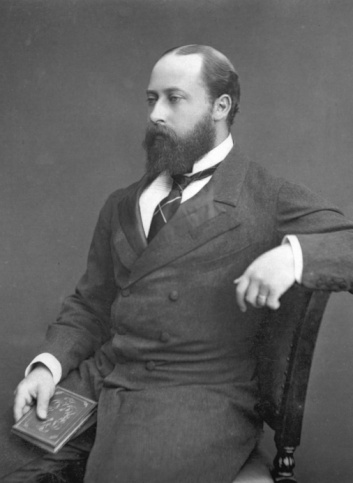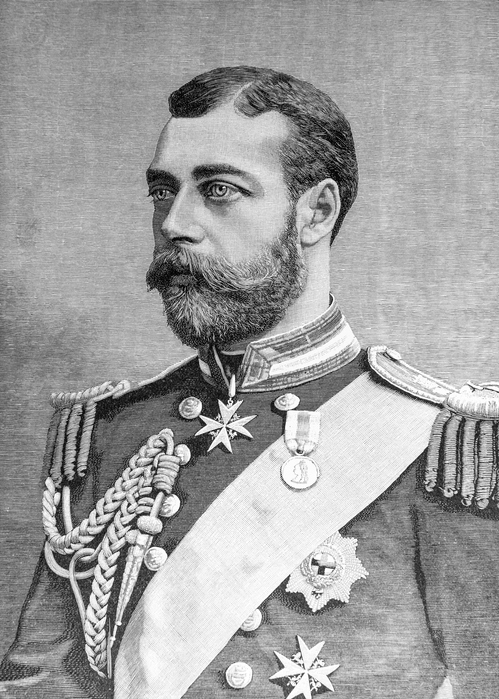This month in history: The death of King Edward VII
On 6 May 1910, King Edward VII died at Buckingham Palace at the age of 68 years old. As part of our ‘This month in history’ series, we look at the death of Edward VII and the accession of King George V.

When did Edward VII become King?
Edward VII became King on 22 January 1901 upon the death of Queen Victoria. The Queen had intended for her son to reign under the name Albert Edward, however he instead chose to reign under the name of Edward VII, stating that he did not want to "undervalue the name of Albert" and his father’s "name should stand alone" (Gazette issue 27270).
The coronation of Edward VII as King of the United Kingdom and the British Dominions, and Alexandra as Queen, took place at Westminster Abbey on 9 August 1902. The ceremony had originally been scheduled for 26 June of the same year but had to be postponed just two days beforehand as the King was taken ill with appendicitis and needed immediate surgery.
A special supplement of The Gazette was published on 28 October 1902 (Gazette issue 27489) and described the coronation in detail, including a moment between then The Prince of Wales and his father: “The Prince of Wales then touched the Crown upon His Majesty's Head, and kissed His Majesty's Left Cheek.”
When did Edward VII die?
Edward VII died at Buckingham Palace on the evening of Friday 6 May 1910. A Gazette Extraordinary announcing the death was published the next day (Gazette issue 28365):
“This event has caused one universal feeling of regret and sorrow to His late Majesty's faithful and attached subjects, to whom He was endeared by the deep interest in their welfare which He invariably manifested, as well as by the eminent and impressive virtues which illustrated and adorned His character.”
Upon Edward VII’s death, his son, The Prince of Wales was proclaimed King George V.
When was Edward VII’s funeral?
Following a private lying in the Throne Room at Buckingham Palace, there was a public lying in state for Edward VII at Westminster Hall from 17 May 1910 until the day of his funeral on Friday 20 May. A special Gazette supplement (Gazette issue 28401) was published on July of the same year describing the laying in state, funeral procession and funeral service in detail.
Lying in state
According the supplement, the “Royal Coffin” was moved “at 11.30 precisely in the morning” on 17 May from Buckingham Palace to Westminster Hall, where a service took place.
During the lying in state at Westminster Hall, “Four Gentlemen at Arms stood at the head of the Coffin, and four Yeomen of the Guard stood at the four corners of the Catafalque. Two Officers of the Household Cavalry and Brigade of Guards were also stationed on either side, and a native Orderly Officer of the Ghurka Rifles at the foot of the Coffin.”
Funeral procession
At “precisely” 9.45 on the morning of 20 May 1910, Edward’s coffin was removed from Westminster Hall and “placed upon a Gun Carriage, and the Crown and Cushion, the Regalia, and the Insignia of the Garter laid thereon” before the procession headed to Paddington Station. It’s estimated that between three and five million people gathered in London to watch the procession.
On arrival at Paddington Station, the coffin was taken from the Gun Carriage and placed in the Royal Train, where it headed to Windsor alongside “the other Royal personages who took part in the procession.” On arrival at Windsor, the coffin “was removed from the train by the Bearer Party of the Brigade of Guards, and placed upon a Gun Carriage drawn by the Royal Navy” before the procession made its way to St. George's Chapel at Windsor Castle.
Funeral service
King George V and Queen Alexandra stood at the head of the coffin during the funeral service, “followed by The German Emperor with The Empress Marie Feodorovna and- the other Sovereigns present, the Royal Princes and the Foreign Representatives.” The Lord Chamberlain of His Majesty's Household “took his place at the Foot of the Coffin.”
The Gazette supplement provides details on the order of the service:
- The Lesson was read by The Dean of Windsor, followed by the Anthem, "His body is buried in peace: but His name liveth for evermore."
- The Prayers were read by The Archbishop of Canterbury, and the Sentence, "I heard a voice from Heaven" was sung.
- The Prayer, "Almighty God, with Whom do live the spirits of them that depart hence in the Lord," was said by The Bishop of Winchester, which was followed by the Hymn, "My God, my Father, while I stray."
- The Collect was said by The Archbishop of York.
- Sir Alfred Scott Scott-Gatty; Garter Principal King of Arms, pronounced the Styles of His late Most Sacred Majesty of Blessed Memory
- The Hymn, "Now the labourer's task is o'er," was sung, and The Archbishop of Canterbury pronounced the Benediction.
The “Company Colour of the King's Company of the Grenadier Guards” was then placed on Edward VII’s coffin by George V before the coffin was lowered into the grave.

When was George V’s coronation?
George V’s coronation took place at Westminster Abbey on 22 June 1911, over a year after his father’s death. A special supplement of The Gazette described the ceremony in detail (Gazette issue 28535), including “The Oath”, “The Anointing” and “The Crowning”, which was conducted by the Archbishop of Canterbury, Randall Thomas Davidson:
“…the Archbishop, having received the Crown from the Dean of Westminster, reverently placed it on His Majesty's Head; when the people with loud and repeated shouts, cried: "God save the King".”
Queen Mary was also anointed and crowned at the coronation by the Archbishop of Canterbury: “The Archbishop thereupon took the Crown from the Altar and reverently set it on the Queen's Head, saying, " Receive the Crown".”
See also
This month in history: The death of Queen Victoria and accession of Edward VII
This month in history: The wedding of Queen Victoria and Prince Albert
Queen Victoria and Prince Albert's Bicentenary
This month in history: The coronation of Queen Elizabeth II
This month in history: Edward VIII abdication crisis
Image: Getty Images
Publication date: 5 May 2021
Any opinion expressed in this article is that of the author and the author alone, and does not necessarily represent that of The Gazette.
